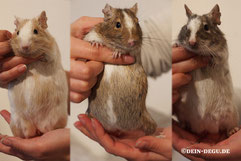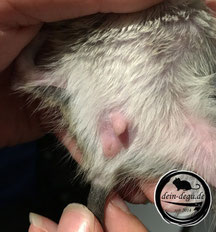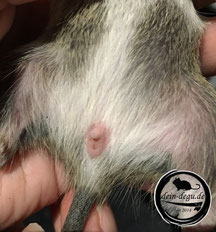Important Information
ONLINE TRANSLATED *WILL BE UPDATED SOON
Topics of this subpage:
- Differentiation between the sexes
- Color genetics
- Age limits
- body weight
- teeth
- Fertility
- Puberty
- Conception age
- cycle
- Teats
- Gestation period
- Number of litters per year
- Litter size
- Stage of development
- Suckling period
- Separation from the mother
- Proof of pregnancy
- pregnancy
- Weight information for the offspring
- Coprophagia ( consumption of feces)
Gender Differentiation
color genetics
The Mendelian rules describe the inheritance process for traits whose expression is determined by only one gene. More on this under color genetics.
AGE LIMITS
Babies: 0-7 weeks old
Teenagers: 7-58 weeks old
Adults: 59 weeks to 5 years
Senior: from 5 years
body weigth
Normal weight adult: 170 - 300 g, Ø230g
Pregnant female: 250 to 430g, Ø340g
Newborns: 10 - 16 g, Ø14g
6th month approx. 180 - 210g
Normal weight of my males approx. 220 - 250g
Normal weight of my females approx. 210 - 240g
TEETH
20 teeth in total, of which on each side:
Upper jaw: 1I, 1P, 3M
Lower jaw: 1I, 1P, 3M
The incisors of the upper and lower jaw are 1: 2-3 in length to each other. The molars of the lower jaw are curved and tilted slightly towards the tongue, those of the upper jaw slightly towards the cheeks. In chinchillas and degus, the incisors should be dark yellow to orange-red in color. The teeth of all these animals also grow for a lifetime. Source veterinary practice Dr. Schindler
The incisors are used for nibbling and gnawing, while the molars are used to grind the food.
fertility
Females: approx. 4,5 years, then decline in reproductive rate
Males: lifelong
PUBERTY / SEXUAL MATURITY
Female: cycle begins at 12-16 weeks, with a body weight of approx. 200 g
Male: from around 3 months of age
For both sexes: at the earliest at 46 days, on average at 6 months (i.e. from 5-6 weeks of age, females can become pregnant in exceptional cases and mate males)
fertilization capable age
Fertile age of the female - minimum age
Approx. 6 months, with a body weight of approx. 205 g
Not older than 12 months with the first litter, so coverage with 9 months at the latest. Ossification of the pelvis, increased risk that the babies get stuck and the mother animal dies (not scientifically proven, assumption based on guinea pigs).
castration
Castration of degus is possible in both females and males. Male degus do not change their behavior, ie the sexual drive and / or aggressions or dominance remain unchanged. The reason for this is that with degus, the testosterones / hormones are not only produced there due to the internal testicles.
According to my vet, castration must not be carried out before the age of 4 months or from 180g body weight at the earliest. After castration, the buck must remain separated from the females for 6-8 weeks, as it is still able to procreate during this period.
Detailed explanation under diseases & symptoms .
cycle of the female
The vagina opens every 20 to 30 days, stays open for 3 to 21 days.
Regular cycle duration of 20.5 +/- 0.5 days.
teats
The female has four teats couples , a inguinales and three more lateral , which are arranged on a line between the rear and front legs .
gestation period
87-93 days +/- 3 days, Ø 90 days
NUMBER OF LITTERS PER YEAR
In the wild: one litter in spring (September, end of the rainy season, large amount of food), two litters when there is enough food.
In captivity: a maximum of 4 litters, i.e. all year round, Ø2-3 litters. The young animals flee the nest.
litter size
1 - 10 babies, Ø 5 - 6 babies
The litter size in Degu varies depending on the age of the female and the number of previous litters. Sex ratio at birth is 100 females to 110 males.
development of the babies
Varying between :
Initially eyes closed and only sparse patches of hair .
At birth, your eyes open and fully hairy.
suckling period
about 4 weeks , at least 2 weeks
Weaning weight : about 60-80 g
Normal food after six to seven days , Ø 2-3 week
separation from the mother
With approx. 7 - 8 weeks / males with 7 weeks with normal development
Isolation after weaning can lead to serious behavioral disorders in degus, which later express themselves in the form of fear of conspecifics and difficult handling by humans.
PROOF OF PREGNANCY
The sonographic examinations of two pregnant degu females showed that a positive sonographic diagnosis could not be made even on day 20 of pregnancy with a low number of fetuses and pronounced sound extinction through the intestinal tract, although the formation of the amniotic cavity in degus around this period on day 12-14 Pregnancy takes place and therefore anechogenic areas in the uterus should also be able to be displayed sonographically. Therefore, follow-up examinations are absolutely necessary in the event of a negative result in order to safely exclude pregnancy in the degu.
From the 6th week of pregnancy onwards, no more sonographic pregnancy examinations should be carried out; the pregnancy may be terminated.
With the current state of knowledge, the sonographic proof of pregnancy in degu cannot be recommended for veterinary practice, on the one hand, because early pregnancy cannot be reliably detected and, on the other hand, the handling of pregnant degus may trigger an abortion.
pregnancy
Cautious handling of the animals in the last trimester of pregnancy and Note in this context to possible miscarriage.

367g (left) on the day of litter (5 babies).
294g (middle) 10 days before the day of birth. On the day of birth 340g (7 babies).
265g (right) 9 days before the day of birth. On the day of birth 290g (4 babies).
On average, pregnant females gain up to 75.5g ± 7.3% above the
UNWANTED OFFSPRING - WHAT DO I HAVE TO CONSIDER?
The nest / house should be moved to the lowest level. Impeller, water bowl and other sources of danger must not be on the lowest level. In the case of aviaries, care must be taken that the grids are not more than 1cm apart - otherwise attach an additional grid. The impeller must be relocated to one of the upper floors, if this is not possible, only put it back into the cage from the third week of life of the young animals.
Male offspring must be separated from the mother / sisters from the 7th week.
The father should have been separated before the birth, otherwise he will mate the female immediately.
Differentiation between the sexes: This is possible from the day of birth.
weights for the babies
The weights listed here are from my experience and may vary quite , as is a sub- Scheid at the litter size , size of the parent animal and age observed. Therefore, they should not be taken as a fixed reference point . Unique numbers I can not call because the weight of the baby is very different , depending on whether there are 3 or 8 babies in a litter .
Newborn ca. 10 - 16g
2. life week ca. 15 - 20g
between 2.-3. life week ca. 30 - 40g
3. life week ca. 35 - 45g
between 3.-4. life week ca. 35 - 45g
4. life week ca. 40 - 60g
between 4.-5. life week ca. 44 - 62g
5. life week ca. 65 - 75g
between 5.-6. life week ca. 75 - 88g
6. life week ca. 70 - 90g
between 6.-7. life week ca. 75 - 100g
7. life week ca. 100 - 120g
between 7.-8. life week ca. 115 - 125g
8. life week ca. 125 - 135g
6. month ca. 180 - 210g
ORIENTATION TABLE
|
date of birth |
age |
litter size and proportions |
weigth in gram |
| G 17.02.2015 | 5 weeks 5 days | 4 Babys | big | 80-83-83-85 |
| 6 weeks 2 days | 95-105 | ||
| 7 weeks 5 days | 116-126 | ||
| H 25.02.2015 | 6 weeks 4 days | 4 Babys | normal | 75-84 |
| 7 weeks 6 days | 102-105 | ||
| I 27.02.2015 | 4 weeks 2 days | 7 Babys | 3 big, 3 normal, 1 small | 26-39-44-46-47-53-59 |
| 6 weeks 2 days | 43-63-64-78-82-92-93 | ||
| 7 weeks 3 days | 75 / 90-95 | ||
| J 15.03.2015 | 1 weeks 6 days | 5 Babys | normal | 14-15-15-16-18 |
| 3 weeks 4 days | 33-41 | ||
| 4 weeks 1 day | 39-42-43-45-46 | ||
| K 26.03.2015 | 2 weeks 3 days | 5 Babys | 2 big, 3 normal | 34-37-38-39-40 |
| 3 weeks 5 days | 49-55 | ||
| L 23.08.2015 | 4 days | 3 Babys | big | 17-18-19 |
| 1 week | 23-23-25 | ||
| 3 weeks 4 days | 52-53-56 | ||
| 4 weeks 3 days | 66-68-71 | ||
| 7 week | 112-114-115 | ||
| M 22.09.2015 | Newborn | 3 Babys | 2 big, 1 normal | 13-15-16 |
| 1 day | 15-17-18 | ||
| 6 days | 22-24-25 | ||
| 2 weeks 5 days | 35-38-41 | ||
| 3 weeks | 39-46-49 | ||
| 3 weeks 4 days | 51-55-58 | ||
| N 12.10.2015 | Newborn | 1 Baby | big | 15g |
| 6 days | 25g | ||
| 2 weeks | 32g | ||
| 3 weeks | 45g |
COPROPHAGIA (CONSUMPTION OF FECES)
Special thanks to Adjet Makawey and his diploma thesis from 2011 "Observations on Caecotrophy or Coprophagy in Dwarf Hamsters, Degu and Chinchilla" from which the following information comes.
KENAGY et al. (1999) described the adaptation of degus to feed availability and digestion. If degus have free access to food for eleven hours during the day, but not for the rest of the day, they consume as much food as if they were fed ad libitum. The same applies if you can only eat 2.5 hours in the morning and 2.5 hours in the afternoon. KENAGY et al. (1999) observed the following difference with regard to feed intake times: those degus who had feed available for eleven hours a day only take back the feces that are produced at night. The excretions that are excreted during the day are not reabsorbed. Those degus, on the other hand, who received food in the morning and in the afternoon, saved the act of coprophagy for the noon, when there was no food available to them.The digestion of the feces during the periods when food is not available ensures a continuous supply into the digestive tract. This seems to represent an increase in the performance of the intestine. BROWN and DONNELLY (2004) also describe the degus' ability to use coprophagy especially when no food is available.
A special movement was observed in degus and chinchillas, which they use to pick up the feces directly from the anus. The idea that the feces that are picked up by this particular movement could be appendix feces, however, could not be confirmed by the laboratory results.
These observations do not entirely agree with the descriptions of BROWN and DONNELLY (2004). BROWN and DONNELLY (2004) describe that only rabbits take up the appendix directly from the anus and that other rodents take up the droppings from the bottom of the cage. KENAGY et al. (1999) show that there is a connection between the lack of feed and increased coprophagia in degus. In the observations made on cecotrophy and coprophagy, however, the animals had food continuously available.
In summary, it can be stated that degus and chinchillas absorb their feces from the anus and practice coprophagia.
All texts and contents are subject to copyright, © dein-degu.de






